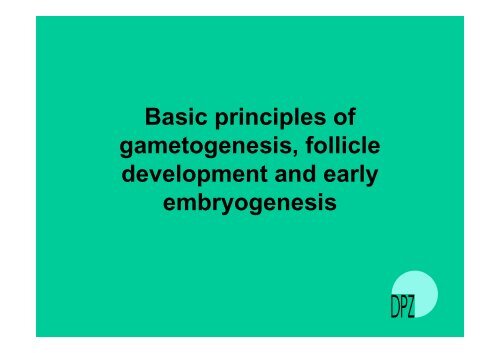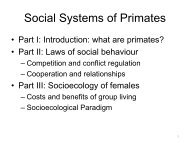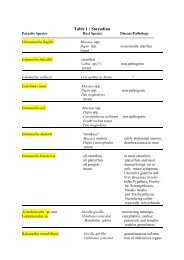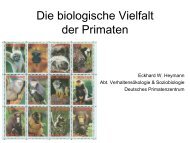Basic principles of gametogenesis, follicle ... - EUPRIM-Net
Basic principles of gametogenesis, follicle ... - EUPRIM-Net
Basic principles of gametogenesis, follicle ... - EUPRIM-Net
You also want an ePaper? Increase the reach of your titles
YUMPU automatically turns print PDFs into web optimized ePapers that Google loves.
<strong>Basic</strong> <strong>principles</strong> <strong>of</strong><br />
<strong>gametogenesis</strong>, <strong>follicle</strong><br />
development and early<br />
embryogenesis
Examples from the marmoset<br />
Snoopy
Male Reproduction
Hypothalamus/Pituitary feedback<br />
for male
Spermatogenesis
Sperm development in marmoset<br />
Complete<br />
Cycle aprox.<br />
37 days<br />
Spermatogonia<br />
Spermatocytes<br />
From Miller et al. 2000<br />
M2<br />
First meiotic<br />
division<br />
Secondary<br />
spermatocyte<br />
Second<br />
Meiotic<br />
division<br />
Progressive<br />
Steps in<br />
Spermatid<br />
development
Meiosis
Sperm Bridges
Marmoset Testicular development<br />
• First testicular differentiation- ~GD 75 (late<br />
embryo stage)<br />
•Birth—tubules contain many genocytes- not in contact<br />
with the basement membrane<br />
• Juvenile (6 months) – pre-spermatogenesis—similar<br />
to gonocytes and fetal spermatogonia<br />
• Puberty (8 months) – first adult spermatagonia<br />
• Post-puberty (12 months +) - some males producing<br />
fully mature spermatazoa.<br />
(rev. Li et al. 2005)
Marmoset testis at birth
Marmoset adult testes<br />
From Miller et al. 2000
Sperm functional maturation<br />
• Spermatazoa are released from the<br />
sperm tubules <strong>of</strong> the testes<br />
• stored in the epididimus and as they<br />
travel along from the caput to the caudal<br />
regions and then to the vas deferens<br />
• where they await mixing with the prostate<br />
and seminal vesicle secretions and<br />
ejaculation.
Marmoset sperm with acrosome<br />
Pope stain, do Valle et al. submitted
Marmoset sperm<br />
post-acrosome reaction
Male Fertility<br />
• How many sperm do you need to be fertile?<br />
• But it is not only number that counts but also<br />
– Motility, speed and pattern<br />
– Acrosome reaction at the right moment<br />
– Opportunity
Seminal plasma and coagulum<br />
• Primate seminal plasma<br />
contains coagulum which does<br />
not liquefy because—<br />
– prostate does not produce PSA (prostate<br />
specific antigen) which is a protease<br />
responsible for liquifaction.<br />
• Macroscopic form <strong>of</strong> the coagulum differs<br />
among the species– but composition not yet<br />
studied in most.<br />
• What could be the function <strong>of</strong> coagulum?
Marmoset sample size<br />
and sperm count<br />
• Average ejaculate volume<br />
25µl<br />
• Sperm count varies from 100<br />
x10 6 /ml to 1,000 x 10 6 /ml<br />
• We don’t yet know the lower<br />
limits <strong>of</strong> in vivo fertility
Seasonality <strong>of</strong> spermatogenesis?<br />
• Seasonal Species<br />
–Rhesus<br />
– Lion Tamarin<br />
– Squirrel monkey
Seasonality <strong>of</strong> spermatogenesis?<br />
• Non/mildly-seasonal<br />
Non/mildly seasonal<br />
Species<br />
– Long Tailed macaque<br />
– Common Marmoset<br />
– Howler monkey
Sperm competition<br />
• What does this really mean for different<br />
species with different social patterns?<br />
• and how can one study it in the field and in<br />
the laboratory?









